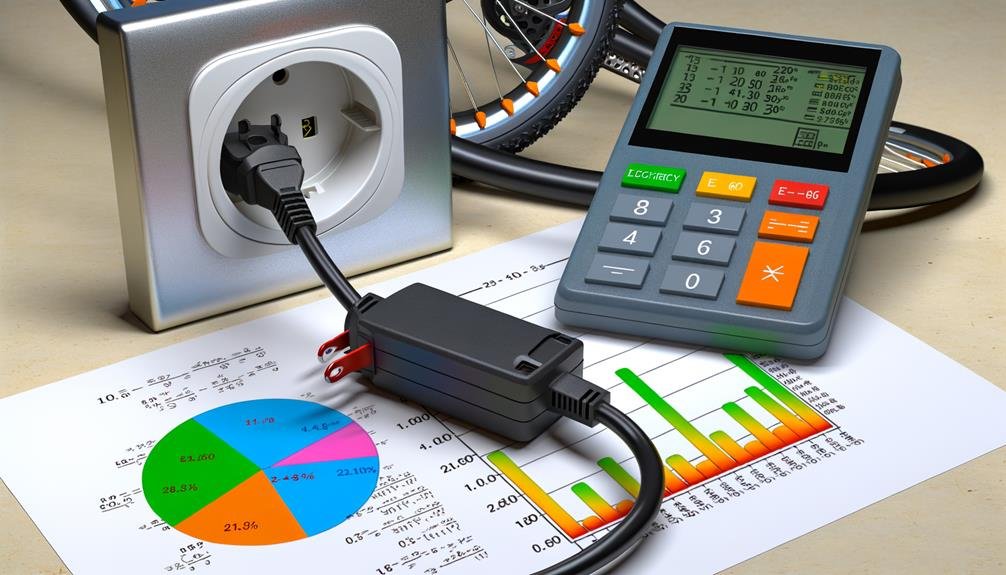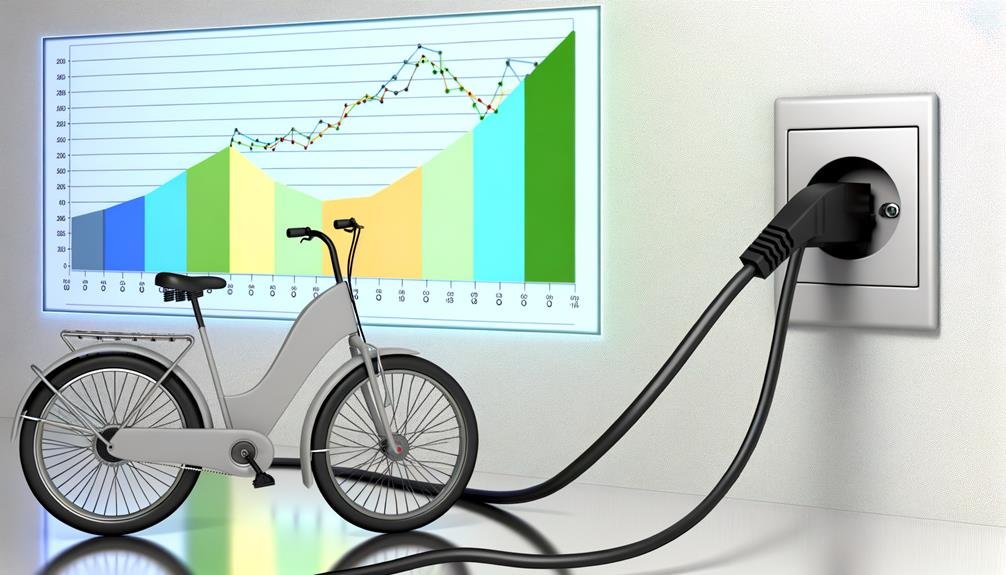Charles Miller is a veteran bike enthusiast with over 12 years of experience dealing with bikes as a mechanic. Despite immense love and expertise for...
As we shift towards more sustainable modes of transport, electric bikes (eBikes) are increasingly becoming a popular choice. The upfront cost of purchasing an eBike is often considered, however, the ongoing expense to charge these vehicles is less frequently discussed.
Determining this cost is not as straightforward as one might presume and is influenced by a myriad of factors ranging from electricity prices in your location to the capacity of your eBike's battery.
This prompts us to explore, how much does it truly cost to charge an electric bike?
Continue on, as we unveil the nuances behind the cost of charging eBikes and provide you with practical insights that might influence your decision on this economical and eco-friendly mode of transport.
- Key Takeaways
- Understanding Electric Bike Costs
- Factors Influencing Charging Costs
- Calculating Your E-bike's Energy Usage
- The Role of Battery Size and Health
- Peak Hours and Charging Costs
- Energy Provider Rates Impact
- Ways to Reduce E-bike Energy Costs
- Comparison: E-Bike Vs Electric Car Charging
- The Real Cost of Charging Your E-bike
- Frequently Asked Questions
- Conclusion
Key Takeaways
- The timing of charging, particularly during off-peak hours, can significantly impact the cost of charging an electric bike.
- Battery size and health play a crucial role in determining the frequency and duration of charging sessions, which in turn affects the long-term electricity costs.
- Maintaining battery health through regular usage, avoiding long periods of battery discharge, and proper maintenance can help minimize charging costs.
- Strategies such as using renewable energy devices, switching energy providers, charging during off-peak hours, and exploring free electricity sources can effectively reduce e-bike charging expenses.
Understanding Electric Bike Costs
To comprehend the costs associated with electric bikes, it is essential to delve into several key factors. These factors include the timing of charging, battery health and size, and prevailing electricity rates. All of these directly influence the overall charging cost.
The cost of charging an e-bike battery is significantly shaped by the timing of charging. It's worth noting that electricity rates fluctuate throughout the day. They reach their peak during high-demand periods and dip during off-peak hours. As such, savvy users may opt to charge their e-bikes during off-peak hours to benefit from lower electricity rates, thus reducing the cost of charging.
Battery health is integral to charging efficiency. Lithium-ion batteries, commonly used in e-bikes, have optimal charging ranges that should be adhered to for maintaining battery health and charging cost-effectiveness. Similarly, battery size plays a significant role in determining charging time and cost. Smaller batteries require less electricity, hence incurring lower charging costs.
Lastly, the cost of electricity per kWh in your region can significantly impact the overall cost. Therefore, understanding these variables will enable users to manage and potentially reduce the costs associated with charging their electric bikes.
Factors Influencing Charging Costs
In evaluating the cost of charging an electric bike, one must consider a range of influential factors. Specifically, electricity rates, which can fluctuate based on time and location, have a direct impact on charging costs.
Additionally, the capacity and health of the bike's battery, including its type and size, is another critical determinant of the overall expense.
Electricity Rates Impact
Electricity rates significantly affect the cost of charging an electric bike. Factors such as peak hours, battery health, battery size, and global supply and demand play a crucial role in determining this impact.
The impact of electricity rates on the cost is determined by the electricity tariff and the cost per kWh. For instance, if the rate is $0.12 per kWh, charging a 500Wh (0.5kWh) bike battery would cost around $0.06 ((0.5 kWh x 1.25) x cost). However, this cost can vary.
Charging during off-peak hours can reduce the cost of electricity, as prices are often lower due to decreased demand. Battery health and size also influence the charging efficiency, thereby affecting the total cost.
Battery Capacity Considerations
While the cost of charging an electric bike is significantly influenced by electricity rates, the capacity of the battery serves as another crucial determinant. Understanding battery capacity considerations can help you calculate the cost more accurately.
- Smaller battery capacities require less electricity per charge, but may need charging more frequently.
- Proper care and maintenance of your e-bike's lithium-ion battery can improve efficiency, reducing the kWh required to reach full capacity.
- Charging your e-bike during off-peak periods can decrease the cost of electricity used.
- Global supply and demand dynamics can impact the cost to charge an electric bike.
- The formula (kWh x 1.25) x cost can be used to estimate charging costs, with 1.25 accounting for energy lost during charging.
Calculating Your E-bike's Energy Usage

To accurately calculate the energy usage of your e-bike, one must consider several key factors, including the battery capacity, the electricity rate, and the overall state of the battery's health. Given the variety of electric bikes on the market, the battery size can greatly impact the kWh usage, and by extension, the cost to charge your eBike.
Take, for example, the following table:
| Battery Capacity (Wh) | Electricity Rate (per kWh) | Charging Costs |
|---|---|---|
| 500 | 0.12 | 0.06 |
| 400 | 0.12 | 0.05 |
| 300 | 0.12 | 0.04 |
The formula used to calculate the charging costs is: `(Battery Capacity/1000) x Electricity Rate`. For instance, with a 500 Wh battery and an electricity rate of $0.12 per kWh, it would cost roughly $0.06 to fully charge the eBike.
The average cost of electricity can vary, meaning charging costs will differ based on location and provider. Additionally, the health of the battery plays a role in charging efficiency, with well-maintained batteries consuming less energy over time. Thus, calculating your e-bike's energy usage can help manage and anticipate future expenses.
The Role of Battery Size and Health
Understanding the intricacies of electric bike charging costs necessitates a thorough examination of the role of battery size and health.
The capacity and condition of the battery directly influence the frequency and duration of charging sessions, thereby impacting cost.
Optimizing battery health through proper care can also significantly reduce charging expenses over the life of the electric bike.
Battery Size Impact
In the realm of electric bike operation, battery size and health significantly influence the charging time, frequency, and overall electricity costs. The battery size and its health determine how much energy is required per charge, hence affecting the costs to charge the bike.
- Larger batteries, though having higher upfront cost, offer greater capacity, reducing the frequency of charge thereby potentially lowering long-term electricity costs.
- Smaller batteries may have lower initial costs, but higher long-term costs due to increased charging frequency and energy inefficiency.
- The health of the battery, particularly for lithium-ion batteries, directly affects charging efficiency and costs.
- Proper maintenance, including adherence to manufacturer's guidelines, optimizes charging efficiency, prolonging battery lifespan and reducing costs.
- Extreme temperatures can degrade battery health, leading to inefficient charging and increased costs.
Maintaining Battery Health
Preserving the health of an electric bike's battery, especially in relation to its size, plays a crucial role in optimizing charging efficiency and minimizing associated costs. Regular usage and not leaving the battery discharged for long periods can enhance battery longevity. E-bike batteries, predominantly Lithium-ion Batteries, perform optimally when maintained well. When charging your electric bike, it's important to fully charge your battery to maintain its health. Partial charging, contrary to popular belief, may degrade the battery health faster. For longer rides, larger batteries with a pedal assist function are ideal, although they may require more power to charge. The key lies in striking a balance between maintaining battery health and efficient energy use.
Cost of Charging
The cost of charging an electric bike is influenced by several factors. One such factor is battery health and size. Smaller batteries generally require less energy for a full charge, but may need to be charged more frequently. Another factor is the cost of energy. The electricity rate per kilowatt-hour directly impacts the cost of charging. Additionally, battery health plays a role in charging costs. Proper maintenance can improve battery efficiency, reducing the energy required for a full charge. Charging during off-peak hours can also reduce the cost of energy. Finally, global trends can impact electricity rates, which in turn affect the cost of charging an e-bike.
These variables make charging an e-bike from a fully depleted battery a process that can vary significantly based on these factors.
Peak Hours and Charging Costs
Often, the cost of charging an electric bike is significantly influenced by the timing of the charge, with off-peak hours generally offering lower rates and reduced demand. During peak hours, the price of electricity often rises due to increased usage, thus raising the expense of charging your battery.
The question, 'How Much Does It Cost to charge an e-bike?' therefore, cannot be answered without considering the impact of peak hours and charging costs. The cost per kilowatt-hour (kWh) can vary greatly during peak and off-peak periods, typically measured in cents per kWh.
Understanding your local electricity provider's rate structure is crucial to reduce the cost of charging an e-bike. For instance, if you live in an area where electricity costs are lower during off-peak periods, charging your battery during these times can lead to significant savings.
Lastly, consider the health and size of your battery. Smaller batteries may need more frequent charges, but this could be offset by their lower overall cost. Properly maintaining your battery, coupled with strategic charging during off-peak hours, can help reduce the cost and extend the life of your electric bike.
Energy Provider Rates Impact

Navigating the landscape of energy provider rates is a pivotal aspect in managing the cost of charging an electric bike, as these rates significantly influence overall expenses. The amount it costs to charge an electric bike can vary significantly, depending on the cost of electricity in your area and what providers decide to charge.
Understanding this can help you to save money and make the most of your electric bike's capacity in kWh x. Here are some key points to consider:
- The cost of a single charge can vary depending on the rate your energy provider charges for electricity.
- Different providers have different rates, with some being at the higher end of the spectrum and others offering more affordable rates.
- The capacity in kWh x of your electric bike's battery also impacts the cost. Larger capacity batteries store electricity and can, therefore, cost more to charge.
- Some energy providers offer time-of-use rates, which can help you save money if you charge your bike during off-peak hours.
- It is beneficial to compare rates from different providers to find the most cost-effective option.
Ways to Reduce E-bike Energy Costs
Exploring various strategies to reduce the energy costs associated with charging an electric bike can lead to significant savings and a more efficient use of resources. Understanding how much it would cost per charge, especially considering the small 300W battery commonly found in many e-bikes, is paramount.
Below is a table highlighting four key ways to reduce e-bike energy costs:
| Strategy | Cost Savings |
|---|---|
| Renewable Energy Devices | Less x 1.25 x cost |
| Switch Energy Providers | Variable, but often less |
| Off-Peak Charging | Up to 50% less |
| Utilize Free Electricity Sources | 100% less |
Using renewable energy devices, such as solar panels, can significantly reduce the cost of charging an e-bike. Switching energy providers or taking advantage of off-peak hours can also result in lower costs. An often overlooked strategy is utilizing free electricity sources, like charging at work or during a coffee break. This can effectively eliminate the cost of charging.
Comparison: E-Bike Vs Electric Car Charging

Shifting our focus from strategies to reduce e-bike energy costs, we now turn our attention to a comparative analysis of charging an e-bike versus an electric car, a pertinent discussion given the increasing popularity of both modes of transportation. Electric cars and e-bikes, while both laudable for their eco-friendly properties, differ greatly in their charging costs and energy consumption.
In evaluating the costs and benefits, consider the following:
- E-bikes consume less energy than electric cars. A typical e-bike battery can take about 500 Watt hours to charge from empty to full, whereas electric cars can consume up to 75,000 Watt hours for a full charge.
- The cost of electricity is capped at a lower rate for e-bikes, with an average of 97 charges per year amounting to around $21.17.
- The cost to fully recharge a typical electric car like the Tesla Model Y can be approximately $9.93.
- A 15-mile round trip on an e-bike costs a mere three cents, showcasing its cost-effectiveness over electric cars.
- Significantly smaller charging costs make e-bikes a more economical option for short commutes.
The Real Cost of Charging Your E-bike
Delving into the real costs of charging an electric bike necessitates an understanding of several influencing factors, including peak hours, battery health, battery size, electricity rate, and global supply and demand dynamics. To truly know the cost, it's crucial to consider these elements.
Peak hours can significantly influence the real cost of charging your e-bike. Charging during off-peak hours, when fewer devices are running and less electricity is in demand, can result in lower costs. However, the health of the bike's battery also plays a role. A healthy lithium-ion battery tends to be more efficient, thus consuming less electricity.
Additionally, the battery size directly impacts the charging cost. Smaller batteries typically require less power, leading to lower costs. However, if the battery is larger, or if it's often charged to its full capacity, the electricity costs could increase.
Moreover, the source of electricity can also affect the overall cost. Renewable energy sources generally have lower costs compared to fossil fuels.
Lastly, consider the additional costs of charging at public outlets or using public transport as alternatives. Understanding these nuances helps in calculating the real cost of charging your e-bike.
Frequently Asked Questions
How Much Is It to Charge an Electric Bike?
The cost to charge an electric bike varies depending on factors such as charging duration, efficiency, battery lifespan, initial setup costs, battery type, use of charging stations, portable chargers, or off-grid charging methods.
Do Electric Bikes Use a Lot of Electricity?
Electric bikes' electricity consumption depends on factors like battery efficiency, power ratings, and charging duration. Energy costs, bike's wattage, electricity tariffs, and usage patterns also play significant roles in determining their overall electricity usage.
Do Electric Bikes Charge When Pedaling?
Some electric bikes, particularly hybrid bicycles with pedal assist systems, can convert energy from pedaling mechanics and regenerative braking into battery replenishment, enhancing cycling efficiency and promoting eco-friendly transportation.
How Much Does It Cost to Add Electricity to a Bike?
Adding electricity to a bike involves costs for bike conversion kits, charging systems, and battery prices. Financial considerations also include maintenance costs, bike longevity, balancing environmental impact, and potential for financial savings.
Conclusion
In conclusion, the expenditure associated with charging an electric bike is influenced by numerous variables, including electricity rates, battery size, and charging efficiency.
Despite slight regional variations, eBikes consistently demonstrate superior cost-effectiveness compared to other modes of transport.
Through strategic utilization of off-peak hours and maintenance of battery health, these costs can be further minimized, underpinning the allure of eBikes as a sustainable and economical transportation solution.

Charles Miller is a veteran bike enthusiast with over 12 years of experience dealing with bikes as a mechanic. Despite immense love and expertise for his Tacoma, he rides his Trek Ebike more. Anytime you meet him, you’ll either hear him talking about Bikes, or writing about all things bikes and cars on this blog.
More Posts


